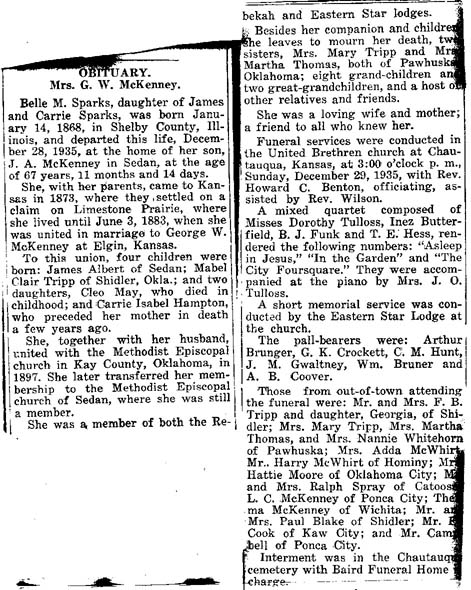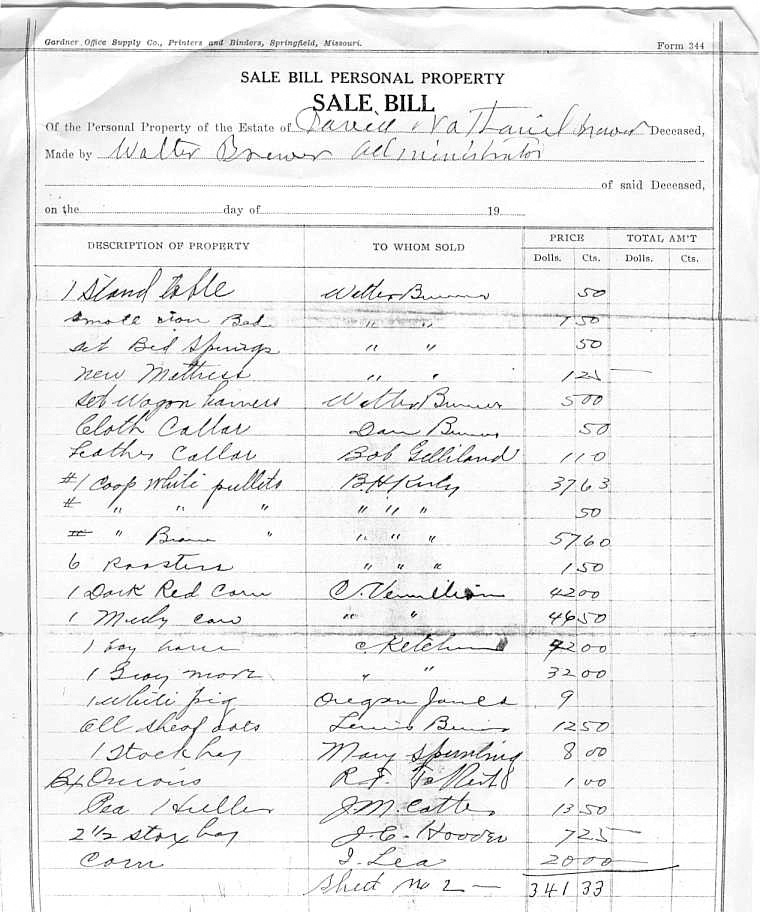Evermore Genealogy
-

Burton Jones
Burton Jones, son of John Levy Jones and Jessie Brewer (daughter of David Nathaniel Brewer and Delana Fowler) was a nephew of our Bettie Brewer Noyes. He was born Sept 24 1917 in Missouri, and died Nov 5, 1975 in Yakima, Yakima, Washington. He is buried at West Hills in Yakima, Washington. He served in…
-

Obituary of Belle Sparks McKenney
Belle Sparks McKenney was the daughter of James Sparks and Carrie Burch, and wife of George W. McKenney Jr. Larry McCombs supplied Belle’s obituary: Mrs. G. W. McKenney Belle M. SPARKS, daughter of James and Carrie SPARKS, was born January 14, 1868, in Shelby County Illinois, and departed this life, December 28, 1935, at the…
-

Personal Property of the Estate of David Nathaniel Brewer
Courtesy of Nancy Benton, we have papers listing the personal property from the estate of our David Nathaniel Brewer. Born Oct 31 1850 at Pleasant, Steuben, Indiana, David married Delana Fowler on March 1 1869 at Osage Mission, Neosho, Kansas. He died Aug 29, 1921 at Greenfield, Dade, Missouri.
-

Van Caldwell and W. W. Baker and the Sac and Fox Agency
Van Caldwell, b. 1799, was brother of Paris Caldwell, b. 1816, who married Margaret Ellen Hackney in 1845 in Wapello Co., Iowa. She was sister of William S. Hackney (direct line of this blog) and daughter of William Hackney and Sarah Shannon. In 1849 in Wapello County, Iowa, W. W. Baker, son of Joshua Wells…
-

Elmer C. Wheeler married Eva Rogers
Though Elmer Wheeler is not immediate family line, I find it often useful with family history to get a better picture when we know not only what was going on with family but with their extended relations and neighbors. Elmer C. Wheeler married Eva Rogers in 1903, a cousin of Antwine Rodman who married May…
-

J. R. Pearson married Rosa DeNoya
Though J. R. Pearson is not family, I find it often useful with immediate family history to get a better picture when we know not only what was going on with immediate and extended relations, but also with neighbors, and the Pearson family resided beside Addie McKenney McWhirt for many years in Osage Indian Territory…
-

L. A. Wismeyer
Though L. A. Wismeyer is not a direct line relation, I find it often useful with family history to get a better picture when we know not only what was going on with family but with their relations. Wismeyer was married to Aggie Huffaker, daughter of Thomas Sears Huffaker and Eliza Ann Baker. Eliza, a…
-
James Bird Jones married Laura Mae Revelett
Though neither James Bird Jones, nor his wife, Laura Mae Revelett, are family, I find it often useful with family history to get a better picture when we know not only what was going on with family and immediate and extended relations, but also with neighbors, and the Jones family was lifting next to our…
-

Thomas Sears Huffaker
Thomas Sears Huffaker was the husband of Eliza Ann Baker Huffaker, daughter of Joshua Wells Baker and Agnes Miller Inghram. Joshua Baker was a blacksmith for the Sac and Fox in Iowa. Eliza’s brother, W.W. Baker, on March 4 1849 in Wapello County, Iowa, married Isabel Frances “Fanny” Hackney”, daughter of William Hackney and Sarah…
-

Eliza Baker Huffaker Obituary
Eliza Ann Baker Huffaker was a daughter of Joshua Wells Baker and Agnes Miller Inghram. Joshua Baker was a blacksmith for the Sac and Fox in Iowa. Eliza’s brother, W.W. Baker, married Isabel Frances “Fanny” Hackney” on March 4 1849 in Wapello County, Iowa. Isabel was a daughter of William Hackney and Sarah Shannon. Though…
Got any book recommendations?